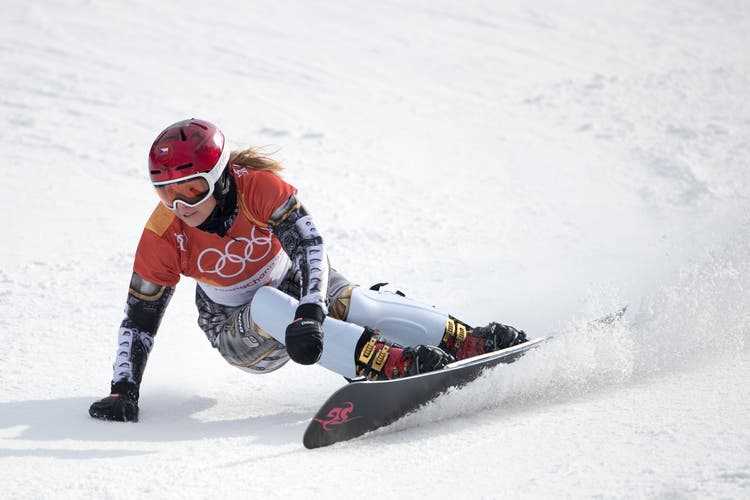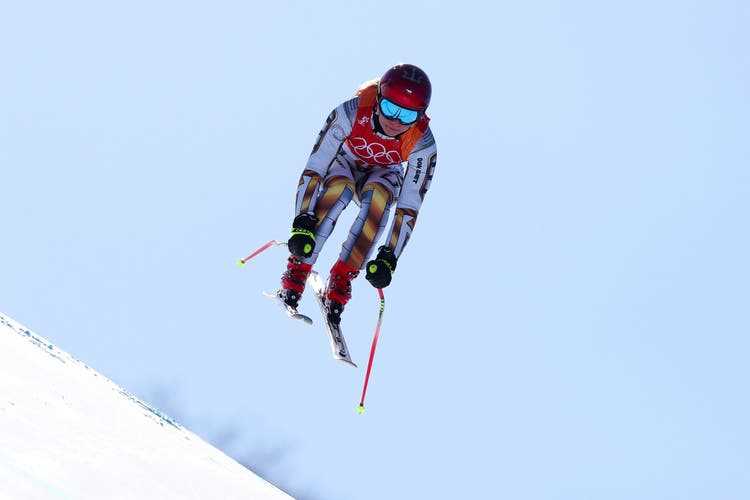Four years after the unbelievable double gold in Pyeongchang, Ester Ledecka also wins the parallel giant slalom for snowboarders in Zhangjiakou. The Czech has long since confirmed the sensational victory in ski racing. But one big old question still accompanies her.
Ester Ledecka is a three-time Olympic champion in two sports.
Probably nobody amazed at the 2018 Winter Olympics in PyeongChang as much as Ester Ledecka. Before the games, the then 22-year-old Czech had been the dominator in the parallel giant slalom snowboard discipline – and on her way to the top as a ski racer. Then, within eight days, Ledecka became Olympic champion in both sports.
The reception in Prague brought back memories of 1998 when the Czech Republic won the first Olympic tournament in the national sport of ice hockey with the NHL stars, with great striker Jaromir Jagr and equally great goalkeeper Dominik Hasek.
And now there is something to celebrate again in the Czech Republic. Ledecka became Olympic champion for the third time on Tuesday, she won the parallel giant slalom of the snowboarders with ease. Another mission accomplished – time for Ledecka to change gear, transform back into a ski racer. The Super-G takes place on Friday, and the downhill on Tuesday.
The reputation of the random winner
As expected as their triumphs in the parallel giant slalom were, whether in 2018 or 2022, that’s how surprising and fortunate it was in the Olympic Super-G four years ago. Ledecka started with the high number 26, after all the favourites, she benefited from the significantly better wind conditions – and prevailed a hundredth of a second ahead of Anna Veith, who had already received the first congratulations on her recent Olympic victory. Lara Gut fell off the podium.
But external conditions shrank to a side note. The story of the snowboarder who stole the show from the ski stars and somehow even made them look a bit stupid was too captivating. At the press conference, Ledecka was still hiding his face behind his ski goggles. She didn’t expect such an appearance and didn’t put on make-up in the morning, she apologized.
On this day in February 2018, the broader winter sports world got to know one of the most extraordinary athletes ever. Ester Ledecka is the first and so far only person to combine alpine snowboarding and alpine skiing at a high level.
The Ledecka Gold Run in Pyeongchang.
Ledecka has long since shed the reputation of being a random winner. Before the Olympic victory in Super-G, a 7th place was her best result in the Ski World Cup. But in December 2019 she won a World Cup downhill, a year later a World Cup Super-G, and in 2020 she finished 2nd overall in the Downhill World Cup behind Corinne Suter. Ledecka invests about twice as much training time in skiing as in snowboarding, and in 2020 she hired an additional trainer for her private team: Franz Gamper, the old fox from South Tyrol, who had previously looked after the Norwegians around Aksel Svindal.
Ledecka shapes snowboarding on a part-time basis
Since the beginning of winter 2019/20, Ledecka has only competed five times in the snowboard world cup; she won three times and came second twice. She missed the 2019 World Cup due to a collision with the World Ski Championships, and the 2021 World Cup due to an injury. It is an indication of both her special class and the low performance density that Ledecka can shape alpine snowboarding so much in a part-time workload.
The power density in the speed disciplines of ski racing, on the other hand, is lower than in slalom and giant slalom. But Ledecka also has that certain something. Tina Weirather, who finished third in Pyeongchang behind Ledecka and Veith, said a year ago before the World Championship races in Cortina d’Ampezzo: “She either wins a medal or she lands in the net. That’s an exaggeration, but she’s an athlete who’s always on the go. Even if it’s hopeless, she would never cross to get back on the line – she stays on the edge. »
Ledecka has been skiing and snowboarding since she was a child, and ever since she set her sights on becoming world leaders in both sports, she has wondered if she would be even more successful as a ski racer if she put her mind to it. Ledecka doesn’t want to know anything about it to this day, she got this duality in her head early on, “it would be sad if I limited myself to one sport,” she said in April 2018 when the NZZ met her in the Engadin.
Always on the move, always on the edge
The snowboard technique, the radical carving on an edge, is reflected in her skiing technique – always on the train, right on the edge. On skis, the pressure is distributed over two edges, and the poles help maintain balance, like the pole in tightrope walking. Carving turns on a snowboard—an edge, no poles, feet strapped to just one board—is a far more difficult balancing act.

“Always on the move, on the edge” – Ester Ledecka, the snowboard Olympic champion.
But sometimes Ledecka’s technique on skis is her undoing, she then seems as if she wants to bang her head through the wall. Conversely, when snowboarding, she benefits from skiing. Her other ski trainer, Tomas Bank, once said that Ledecka felt like snowboarding in slow motion after ski races, “as if she were changing from a German autobahn to a normal road”.
Ledecka is particularly good at reading snowboard courses, she benefits from the fact that visiting, memorizing and ultimately mastering downhill runs is much more complex; Downhill runs are more diverse, unrhythmic, interspersed with jumps, gliding passages, various curve radii.
Fancy, headstrong
Strength and conditioning training is very similar. Swiss alpine boarder Dario Caviezel says it’s not very different from what his cousins, ski racers Mauro and Gino Caviezel, did – “we all need strong legs”. When Ledecka trained with the Swiss team on the Stelvio last autumn, Caviezel also ran parallel runs against her. “For a long time she was level on the flat, I was only faster on steep slopes,” says Caviezel, who celebrated his first World Cup victory in December but, like all Swiss, retired early on Tuesday. “You can learn a lot from Ester, she is always fully focused and stretches her hand forward on the finish line even when the opponent has already been eliminated.”
As an antithesis to the usual, Ledecka comes at the right time for those sports experts who propagate a departure from the ever earlier specialization in top-class sport. Tina Weirather said that when Ledecka first appeared in the Ski World Cup in 2016, she thought: “‘What a crazy idea to want to do two sports at the same time!’ I grew up so that you decide for something and then just do that , right for that. Really fluffy.”

Ester Ledecka is the first and so far only person to combine alpine snowboarding and alpine skiing at a high level.
Ledecka, whose father is a musical composer and pop star in his home country, is considered an unusual, headstrong person. You often don’t know if she’s serious about something or if she’s flirting. In both the snowboard and ski scene, most of them find it pretty cool and a little bit crazy. Hardly anyone comes close to her.
“I know her better than anyone else,” says Nevin Galmarini, the 2018 Graubünden Olympic snowboard champion. “But it’s difficult to make friends with her. She’s not really part of the snowboarding family because she has a different lifestyle.” The commuter between two tours surrounds herself primarily with her private team, which is led by her mother, a former figure skater.
Hiding her face behind ski goggles suits this incredible woman quite well. Ledecka has long made a trademark out of it.
